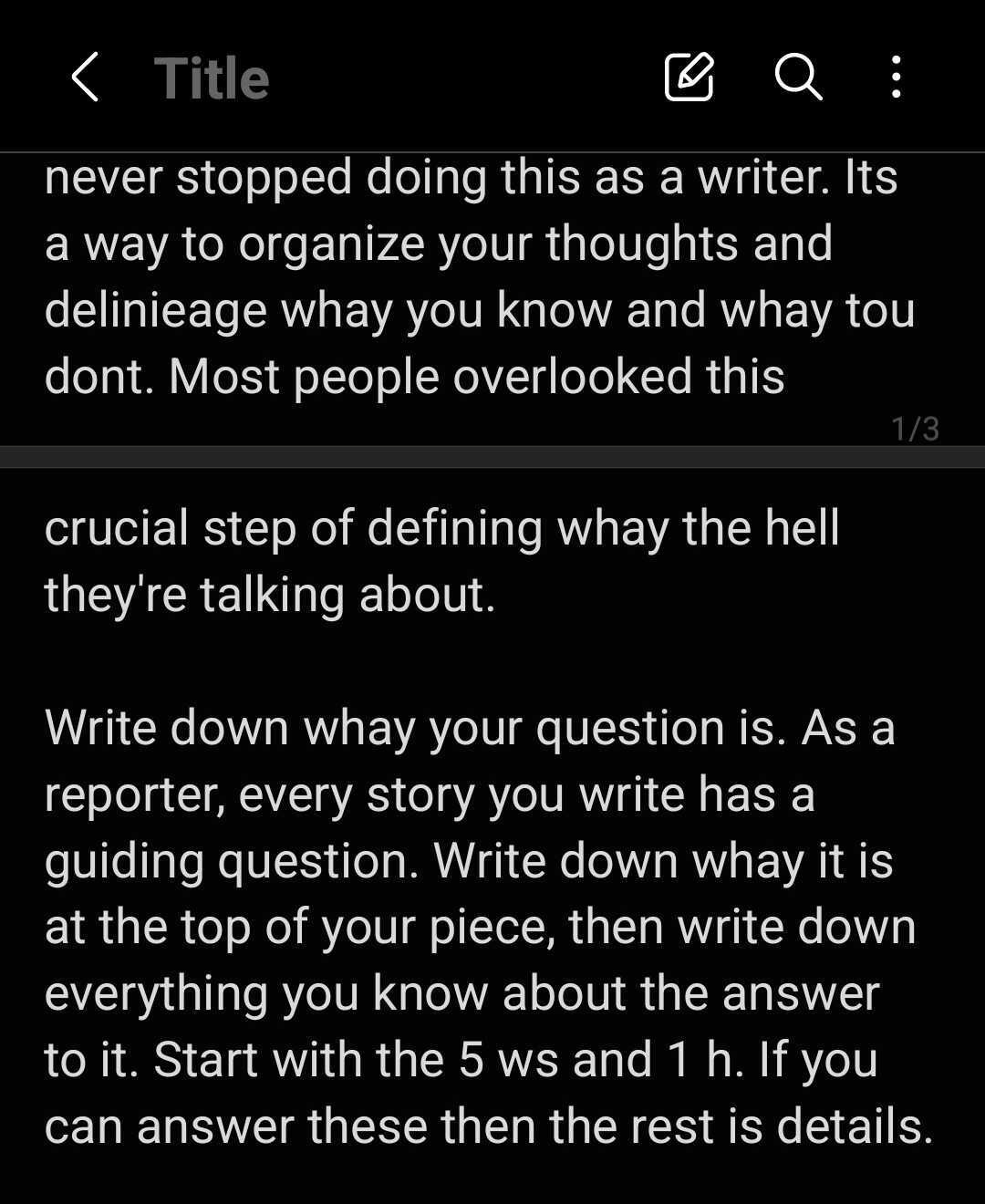How I Beat Writer's Block
Tips from a journalist on how to overcome that blank page once and for all

Writing is easy. You only need to stare at a piece of blank paper until a drop of blood forms on your forehead. – Gene Fowler
I’ll let you in on a little Writer Secret™: Even professional writers hate the blank page.
Having written professionally for nearly two decades, I can assure you that opening a blank document is just as scary and intimidating the 847th time as it is the first.
That expanse of white space stretches out like freshly fallen snow: perfectly empty, perfect in its emptiness. Don’t stare at it too long, lest it stare back into you.
However, journalists don’t have the luxury of being mired in existential dread. We have deadlines to meet. Stories to file. So we write on command. Because we must.
That said, overcoming writer’s block isn’t that hard if you follow a few time-tested tricks. I’m sharing them with you now in case they might help you out of your next staring contest with the snow field.
Write Down Your Guiding Question
Questions are bedrock, not just for journalism but for all storytelling. We humans want to know. If we don’t know, then we ask questions until we do. Simple as that.
It is a journalist’s job to ask questions, even about topics in which they have no natural curiosity. After all, most beat reporters don’t graduate J-school with dreams of covering school board meetings or zoning laws. Yet they do it anyway, because someone out there is depending on them to tell the stories that need to be told.
Every story a journalist writes has a guiding question, and your blog piece or monthly commentary probably does, too. So write down that question at the top of your document. (Et voila! No more blank page.)
Here are some examples of guiding questions:
What new developments occurred at yesterday’s SEC meeting?
Why did this investment’s price decline last quarter while others did not?
How will this new tax plan impact your clients’ long-term savings?
You get the idea.
Note that the questions above do not have binary, ‘yes or no’ answers. ‘Yes or no’ questions don’t lead to storytelling; they lead to fact-finding missions. If you find yourself stumped because you’re trying to answer a ‘yes or no’ question, try rewriting it to make it more open-ended.
For example:
“Do passive investments break equity markets?“
This is a ‘yes or no’ question and is hard to answer simply. Instead, you could rewrite as:
“How do passive investments break equity markets, and under what conditions?”
Or:
“Why do people still believe the myth that passive investments break equity markets?”
Explicitly writing down a question may seem like a simple step. Yet you’d be surprised how often “writer’s block” simply boils down to not knowing which question you’re trying to answer.
Write Down Everything You Know about the Answer
Once you have a question, you can begin to answer it. To do this, you need to gather your facts and organize them into a coherent argument or narrative.
Starting this task from scratch can be overwhelming, especially if you have a lot of data to sort through. I recommend beginning with the 5Ws & 1H:
Who?
What?
Where?
When?
Why?
How?
Every story must address these six elements for our brains to consider that story “complete.” If you miss one, your poor mind will get stuck in an endlessly spinning loading bubble:
That said, you have considerable flexibility in how you address the 5Ws & 1H. For example, the “who” could refer to:
The people most impacted by a change
Who is making the change happen, or trying to stop it
The people who have succeeded—or failed—spectacularly at a task
Someone who studies a topic for a living, and what they think about it
And so on. Matching your facts to the 5Ws & 1H creates order from chaos. It gives your research structure and helps builds a scaffolding on which you can hang your argument or a narrative, whatever it might be.
Answering the 5Ws & 1H is also an ideal opportunity to list any relevant source quotes, statistics, chronological dates, and other supporting literature that may be necessary to answer the question at hand.
Define Jargon or Unusual Terminology
As an editor, I’ve been fortunate to work with brilliant writers from diverse backgrounds and areas of expertise (and I still do, in fact! If you need an editor, feel free to DM me).
Regardless of who I collaborated with, my number one piece of feedback was always the same: You need to define what you’re talking about.
Clear, concise definitions are the glue that holds complex or technical writing together. If you and your reader aren’t on the same page regarding the meanings of words, then communication between you two becomes impossible. Your reader will stumble over unfamiliar terms and give up before they ever get to your main point.
If you find yourself stuck, defining terms is an excellent starting point. No matter who your intended reader is, you should define every term, jargon, data point, and statistic as if the reader will encounter it for the first time. You never know what a reader may or may not already understand.
Besides, this exercise will also ensure you grasp the material fully, too.
Take (Messy) Notes
Your brain is obsessed with knowing things. When it encounters a tantalizing question, it works constantly on the answer, even if you’re not consciously trying to solve the problem. As such, “inspiration” isn’t some magical lightning strike out of nowhere; it’s your brain finally discovering a potential solution to whatever problem with which it’s currently obsessed.
However, once your brain has arrived on that solution, it won’t linger. Instead, it’ll move onto the next head-scratcher. That already answered question is old news, requiring no more brain space—or memory storage.
This is why I firmly believe you should write things down as they come to you. Because you might not be able to remember them later!
I used to carry a small notepad for just this task, but more often than not, I found myself writing on the backs of napkins and receipts. I’d even jot down notes on my hand, if nothing else was available.
These days, I’ve traded napkins for the Notes app on my phone. In fact, I wrote most of this post using it. Granted, my original draft was riddled with typos, autocorrect errors, and sentence fragments; it required plenty of clean up and fleshing out, too. But my brain had solved the puzzle, so I wanted to capture that inspiration before my mind moved onto the next question:

The point is, when inspiration strikes—and it rarely does—don’t tell yourself, “Oh, I gotta write this down later.” Just write it down. Now. On whatever you have handy.
That way, when you next sit down to write, you won’t be starting from a blank page. Instead, you’ll be refining your notes—which, I promise, is much easier.
Write Through Your Feelings
If all else fails and you’re still stuck, write about being stuck. For example:
I’m stuck right now. I can’t figure out what to say. I know A and B, and I have the data for C, but I can’t seem to figure out how A and B lead to C.
You won’t use this writing, of course, but it warms up your brain in the same way jumping jacks get your muscles ready for exercise. Free-writing your feelings primes your brain to find the answers to questions by writing through them.
Free-writing feelings also helps you recognize your current state of mind. It can reveal any pressing physical or emotional needs that are quietly distracting you from the work, such as hunger, thirst, fatigue, and so on.
How to Break Writer’s Block
Here’s my tried-and-true method to skipping past writer’s block. Whenever I sit down to tackle a new writing project, I first:
Write down the question I seek to answer,
Organize the facts by listing out the Who, what, where, when, why, and how,
Compile additional context, like quotes, statistics, data points, chronological dates, etc.,
Transcribe any messy inspiration I have in my notes,
And if I really need it, write through an emergency “gut check” about my feelings.
By the time I’ve completed these steps, I’m usually well on my way to a first draft or at least an outline. The blank page holds no existential power over me anymore, because by that point, it’s long gone.
Until next time, that is.
Do you have any tips and tricks to beat writer’s block? Please share in the comments below!



